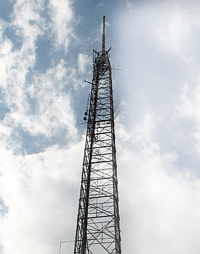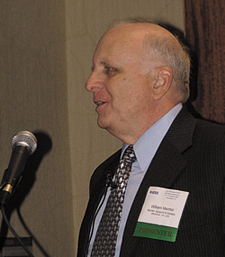FCC Lacks Focus on Transition
ALEXANDRIA, VA. Bill Meintel, speaking at the IEEE's 58th annual Broadcast Technology Society symposium here, contends that there are still numerous issues to be resolved before next February's DTV full scale rollout and says that the FCC and others involved don't seem to be fully focused on them.

Meintel, a partner in the consulting firm of Meintel, Sgrignoli & Wallace, was one of the presenters at last month's event which featured presentations by several industry leaders on broadcasting-related technologies and issues.
"We don't know what's going to happen," said Meintel in referring to the post-Feb. 17 television world. "We're hoping for the best, but need to prepare for the worst."
WARNING SIGNS
In his presentation, "The U.S. DTV Transition-Will February 18, 2009 be a Catastrophe? What are the Problems and How to Fix Them," Meintel flagged several "warning signs" that could signal at least some view inconvenience, if not a major train wreck. These include:
- Lack of education at all levels
- Some 700 stations are changing channels in February;
- There is no requirement for DTV service to replicate analog coverage;
- Too much confidence in DTV converter boxes;
- Too much confidence in cable/satellite service providers;
- The country's worsening economic situation.
Meintel said that the effect of ignoring these transition elements could cause a range of problems, including some that might be termed "catastrophic."
"It all depends on how you define catastrophe," said Meintel. "Is it going to be nationwide, local, affecting your station and your viewers? I think the metric could be defined as the percentage of viewers that will lose service [in] February."
EDUCATION NEEDS
In speaking about the problematic and mostly neglected transition factors, Meintel said the "education" factor especially troublesome.
"There's a real lack of education, he said. "From what I've seen, it ranges from 'the transition is coming; get ready, the end is near' to 'how to connect your converter box.' It needs to go well beyond this. The government hasn't been educated very well either, I think it fails to understand the complexity of making this transition and has lost sight of the goal of continuity of service."

Bill Meintel
Meintel noted that some broadcasters have been only addressing their own "private" problems and not cooperating with their peers in creating partnerships to prepare for the transition. He also has issues with some of the set-top boxes being sold to allow analog receivers to tap DTV transmissions.
"The boxes are not all created equal—this is from my own experience," he said. "Some lack the necessary features; these were not really included in the NTIA coupon program. I'm also a little skeptical about whether the boxes in the stores actually meet the standards of the boxes they gave to the NTIA.
His DTV transition concerns also extend to viewers served by CATV or satellite distributors.
"How about non off-the-air service providers?" he asked. "Will the satellite and cable people get this right in February when the stations change channels and so forth? My personal experience with a major provider—who shall remain nameless—is that they've failed badly in handling small problems."
HARD TIMES
A brand new transition factor is the recent stock market meltdown.
"The economy has to be factored into this too," Meintel said. "The number of over-the-air viewers may increase when people decide they can't afford cable and satellite anymore. There also could be some broadcasters who may not be around come February—this will be a real loss of service."
Meintel said transmission facility changes are also a factor.
"We've got situations where broadcasters have to change channels in February," he said. "Is all this going to get done? I suspect that most will, but I think that it's doubtful that they'll all make it. And I think that some of them will make it, but they but may not have the facilities that are desired then."
He added that the large number of channel changes is going to affect viewers too.
"There'll be band changes affecting antennas and receivers that the consumer has to know about," Meintel said. "It's also going to require rescanning all of these set top boxes and receivers. If viewers don't, then they're not going to get all of the channels. The cable and satellite people are going to have to deal with this too."
Even if set owners and satellite/ wired service providers do get it right, service loss is still possible due to weak or missing signals.
"There are a number of stations who have filed applications with the FCC to maximize their facilities and this may help with coverage issues," Meintel said. "But a good many of these are not going to get built by February and a significant number haven't even been approved yet, and that's a real concern. Another thing is that there's never been any requirement that DTV service replicate analog. You've got post-transition facilities that are based on this non-replication of analog service."
DTV RECEPTION
Meintel also identified problems associated with lessened signal strengths and inadequate receiving antennas.
"Since DTV doesn't fail like analog, this is likely to be the biggest problem around the country," Meintel said. "You're going to have locations where you had marginal analog service before the transition and digital service will fail. These locations are likely to be more prevalent closer in to the station where people are using indoor antennas now for analog. It may not be much of a problem out near the fringe."
Meintel noted that both analog and digital TV services are predicated on outside receiving antennas located 30 feet above ground, but as analog reception is quite forgiving, this requirement has largely been ignored.
He revealed that a sample DTV service study of a nine-station market performed by his company predicted that under ideal conditions, 1.1 percent of off-air viewers, using only indoor antennas, and living 20 miles away from transmitters, would lose service. In a typical environment, this figure will likely rise to 14 percent. The study shows that in a worst-case scenario, 40.5 percent of viewers could lose off-air television.
"At 20 miles and less, people will typically be using indoor antennas," Meintel said. "I believe that this is where most of our problems are going to be coming from."
SOLUTIONS OFFERED
Meintel issued a number of suggestions to make the transition smoother, saying that more had to be done that just showing viewers how to connect STBs. He called for a national call center clearinghouse to answer viewers' questions and assist them in resolving reception problems.
"This can't just be a Web site with a list of FAQs," Meintel said. "It will need navigation tools to help people find a solution for their particular problem."
He said side issues such as white space interference need to be tabled for the present, and full attention focused on the cutover.
"All these problems could lead to a real disaster. The government and others have to act quickly."
The professional video industry's #1 source for news, trends and product and tech information. Sign up below.
James E. O’Neal has more than 50 years of experience in the broadcast arena, serving for nearly 37 years as a television broadcast engineer and, following his retirement from that field in 2005, moving into journalism as technology editor for TV Technology for almost the next decade. He continues to provide content for this publication, as well as sister publication Radio World, and others. He authored the chapter on HF shortwave radio for the 11th Edition of the NAB Engineering Handbook, and serves as contributing editor of the IEEE’s Broadcast Technology publication, and as associate editor of the SMPTE Motion Imaging Journal. He is a SMPTE Life Fellow, and a member of the SBE and Life Senior Member of the IEEE.

